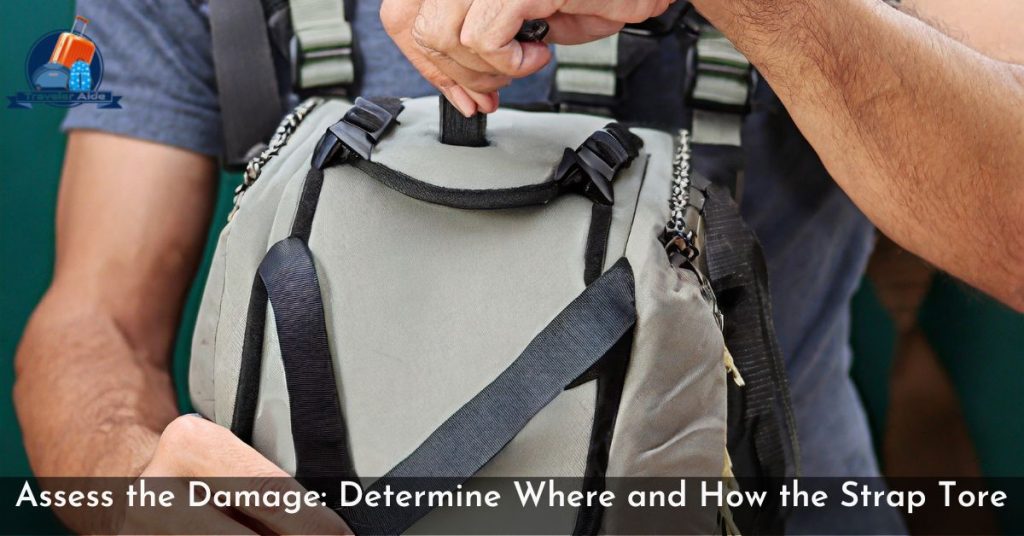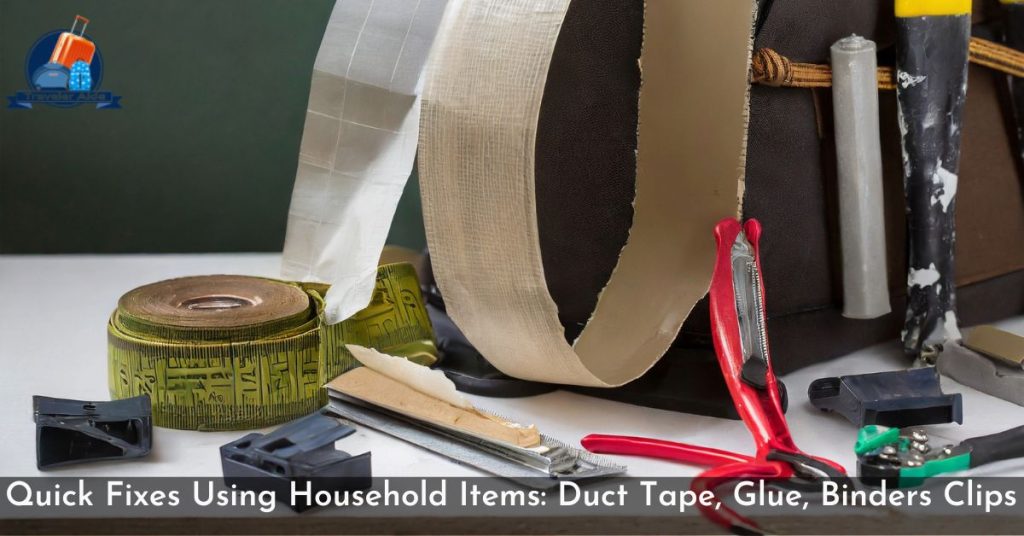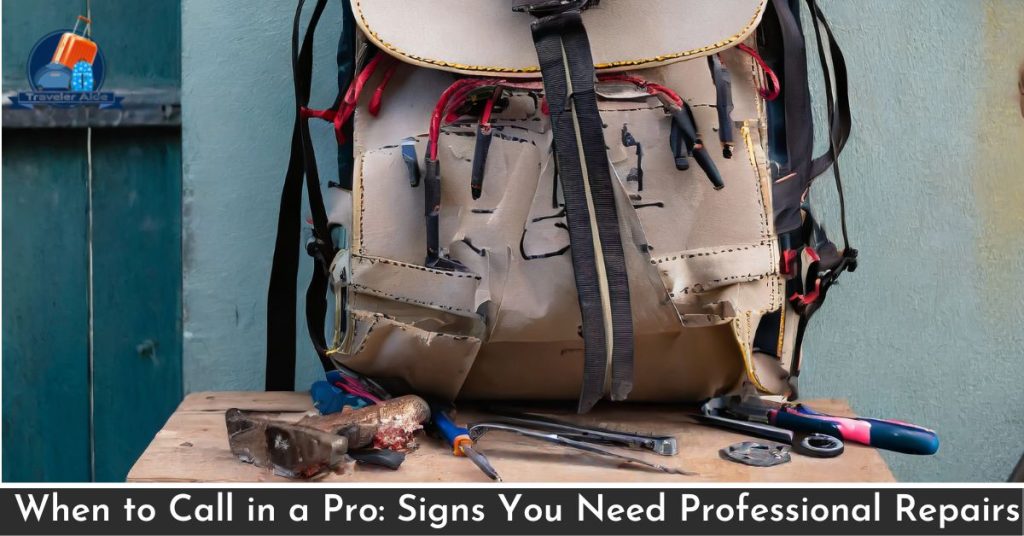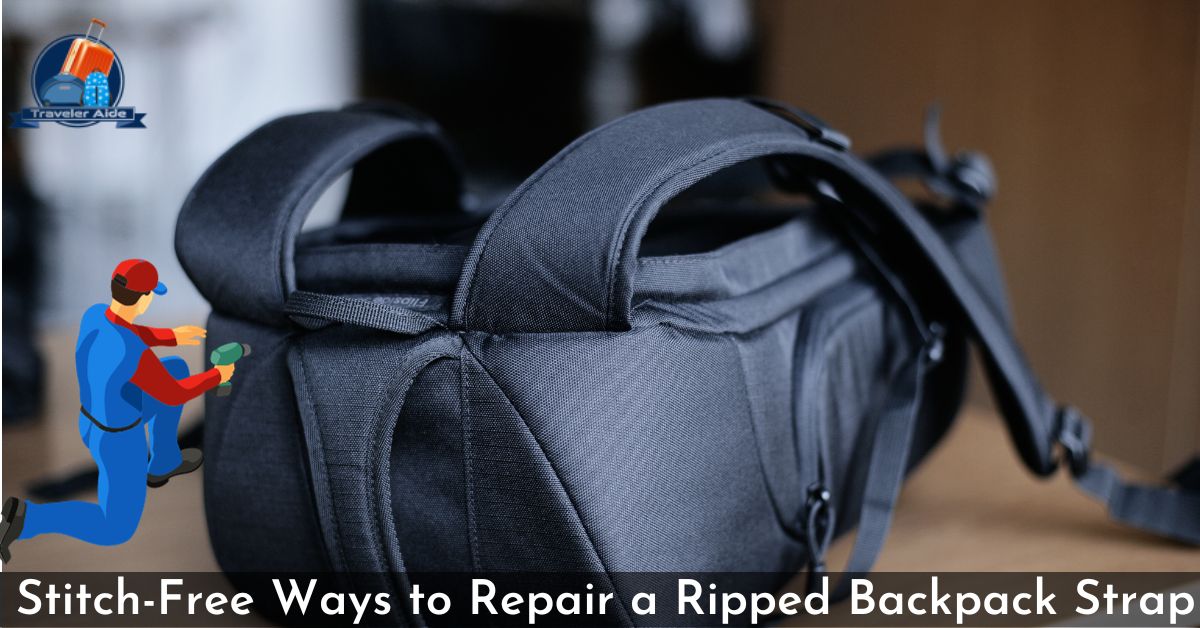Strap ever torn on your favorite backpack right before a big trip or commute? You can fix the damage without sewing—no need for a needle and thread. You likely have the necessary supplies already on hand to put in place an easy fix and be on your way. I’ll cover on Stitch-Free Ways to Repair a Ripped Backpack Strap in this research.
With a few basic techniques, that torn strap doesn’t have to slow you down or cut your outing short. In just a few minutes, you can reinforce and strengthen the strap to get you through your day. Make sure your backpack is in good condition to avoid getting stuck with a broken strap. Use these methods to keep it from tearing.
I know how frustrating it is when a strap gets damaged while traveling. I am here to help you fix it from my experience and make your travel companion look as good as new.
Assess the Damage: Determine Where and How the Strap Tore

To check your backpack strap’s damage, examine where and how the strap tore.
Location of the Tear
Carefully inspect the entire strap to determine the exact location of the rip or tear. Please indicate the location and extent of the damage on the strap. Also check if the tear extends to the point where the strap attaches to the backpack. Knowing the precise site and extent of the damage will help determine the best DIY repair method.
Type of Tear
Next, evaluate what kind of tear it is. Common types include:
Straight Rip
A clean slit or cut across part of the strap. These are often repairable with strong adhesive tape or patches.
Jagged Tear
An irregular, frayed tear with loose straps threads. May require reinforcement with tape/patches and possibly stitching for durability
Detached Strap
If the strap has come off the backpack, you’ll need to fix strap with strong glue, rivets, or sturdy stitching.
Buckle Or Adjustment Damage
Make sure all buckles, straps, and adjusters are still attached and working well. Repair or replace damaged components as needed.
To choose the best solution for fixing your backpack strap, figure out how and where it tore. You can repair it yourself without sewing. If you’re patient and have the right supplies, you can fix your travel companion easily.
Quick Fixes Using Household Items: Duct Tape, Glue, Binders Clips

If your backpack strap is torn, you can fix it without sewing. Use household items.
Duct Tape
Duct tape is a versatile solution that can bind and reinforce the damaged area. Clean and dry the torn strap thoroughly. Apply multiple layers of duct tape over the entire tear, smoothing out each layer to adhere it firmly. Wrap the tape around the strap and seal all edges to prevent peeling. The duct tape should hold securely, but you may need to reapply if it starts to loosen or come undone.
Super Glue
Cyanoacrylate glue, commonly known as super glue, works well for small to medium tears in backpack straps. Hold the torn edges of the strap together firmly for 30-60 seconds as the glue dries to form a strong bond. Apply additional glue to the seam for reinforcement. Super glue can make an area feel stiff and a little uncomfortable. To add more cushioning, you can put duct tape on top.
Binder Clips
If your backpack strap has a small tear or hole near the edge, you can fix it easily with binder clips. Grasp the torn portion of the strap between the binder clip jaws to clamp the material together. Binder clips come in a variety of sizes, so choose one that fits snugly over the width of your particular strap. If the metal clips are uncomfortable, you can cover them in duct tape, cloth, or rubber pads.
You can fix your backpack strap without a needle and thread by using these items. Choose a solution based on the damage type and size. Your gear will be working again soon.
Longer-Lasting Solutions: Fray Check, Iron-on Patches, Reinforcing With Webbing
Once a backpack strap rips, it can be difficult to repair without sewing. But, there are a few ways to strengthen and extend the life of a damaged strap, without sewing.
Fray Check
Fray Check is a liquid seam sealer that can be used to seal frayed, torn or cut straps and prevent further damage. Simply apply the product directly to the damaged area, allowing it to dry completely. This will harden and seal the fibers, creating a durable patch. Fray Check dries clear and pliable, allowing continued normal use of the strap. For larger tears, you may need to apply multiple coats, waiting for each to dry, to fully reinforce the area.
Iron-on Patches
Iron-on patches provide an easy way to patch holes and tears in a strap without stitching. Look for nylon or canvas patches that can withstand high-stress areas. Clean and rough up the area around the tear to provide a good bonding surface. Cover the tear with the patch. Follow the instructions on the package. Use firm and even pressure while ironing. The heat will activate the adhesive and bond the patch in place. For the strongest hold, allow the patch to cool completely before using the strap. With proper adhesion, iron-on patches can last through many uses and washings.
Reinforcing With Webbing
If the straps are very damaged, you can strengthen them by adding strong webbing. Cut a section of nylon webbing to size and position it over the damaged area. Follow the instructions to use strong tape or epoxy to secure the webbing. Press firmly to adhere it in place, then let it cure as directed. The webbing will distribute the stress over a larger area, preventing further tearing. This method works best if there is still intact strap on either side of the damage to adhere the webbing to.
Sometimes, a torn backpack strap can be fixed without stitches, so you don’t have to buy a new one. Continued monitoring of the repair is suggested, however, to ensure long-lasting results.
Preventative Measures: Ways to Avoid Rips and Tears in the Future
To avoid future damage to your backpack strap, you can take a few precautions.
Use a Protective Cover
Placing a protective cover, sleeve or pad over the straps can help shield them from wear and tear. Look for a cover made of a durable, abrasion-resistant material like nylon or canvas. To keep the cover from strap slipping, use Velcro, snaps, or straps to securely fasten it to the strap.
Distribute Weight Evenly
An unevenly loaded backpack can put excess strain on one strap, causing it to weaken or tear over time. Make sure heavy items are distributed evenly across the pack or placed towards the center, close to your back. Tighten all straps and secure any loose webbing to prevent excess movement.
Limit Unnecessary Stress
To prevent damage, don’t hang heavy things or pull forcefully on your straps. When putting on or taking off your pack, do so carefully without jerking the straps. Check that all straps and the main body of the pack are in good condition. If any parts are damaged, fix or replace them to avoid more wear.
Use Quality Hardware
Strap adjusters, clips, and buckles of good quality are less likely to break and damage the straps. Replace any low-quality plastic hardware with aluminum alloy components, which are more durable. Lubricate all moving parts regularly to prevent jamming.
Inspect and Repair Straps Regularly
Check your backpack straps regularly for any signs of damage or wear. Look for fraying, tearing, or broken stitching. Address any issues promptly to avoid complete failure of the strap. You can fix small problems by following the steps in this article. If the damage is severe, it’s better to get help from a professional gear repair service. Preventing a problem is more effective than fixing it later.
To make your backpack straps last longer and avoid tears, take care of them and follow these tips. An undamaged pack means you can continue your adventures uninterrupted.
When to Call in a Pro: Signs You Need Professional Repairs

You can fix small tears in backpack straps at home, but some damage needs professional repair. If your backpack strap has any of these issues, it’s best to reach out to a professional repair service.
Complete Separation of Strap
If the strap is completely off the backpack, it needs to be professionally fixed or replaced. To reattach a strap, sew and strengthen the area around the attachment point. This helps spread the weight and prevents it from coming apart later. If you fix your home like this, it might break and hurt you.
Fraying or Tearing Near Strap Attachment
If the strap attachment area on the backpack is damaged, it needs to be checked and fixed by a professional. This high-stress area needs to be reinforced to prevent the strap from tearing away from the pack. A gear repair service has the tools and knowledge to assess damage and make lasting repairs.
Excessive Damage Throughout Strap
If the backpack strap has tears, holes, or fraying areas, it may not be strong enough to hold heavy things. To fix it, get a professional to repair or replace the damaged strap for safety. If the strap has only a few minor repairs needed, you can fix it temporarily. But if there is a lot of damage, you should get professional help to fix it properly.
Heavy Loads or Critical Use
If your backpack has heavy or valuable things, it’s best to get experts to fix any strap or attachment damage. To prevent failure at a bad time, the pack needs repairs that are as good or better than the original. If you have these backpacks, it’s better to ask professionals for repairs and parts.
In short, small damage to backpack straps can usually be fixed at home. But for more serious problems, it’s better to get help from professionals. They’ll make sure the solution is safe and lasts a long time. If you have doubts about the damage or repair of your home, contact a trusted repair service. Your safety and gear longevity are worth the investment.
Conclusion
You now have several options to repair a torn backpack strap without sewing. Any of these methods can get you back on the trail quickly. The key is to choose a solution that meets your needs for durability and aesthetics. If you need your backpack for a long time, it’s better to replace the straps or get professional repair.
Duct tape or super glue can be temporary fixes. Backpacks are an important investment, so take the time to fix it right. You can quickly repair your backpack strap and get it ready for adventure.
Get out there and keep exploring!

Hey, I’m Dorothy E. Turner! I’ve spent years exploring the world and diving deep into the travel scene. Along the way, I’ve developed a real knack for understanding what makes a great travel backpack. I’m passionate about sharing my expertise to help fellow travelers find the perfect backpack for their adventures.



2 thoughts on “Stitch-Free Ways to Repair a Ripped Backpack Strap”